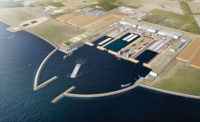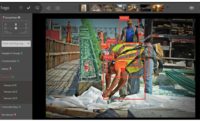
The impact of the COVID-19 pandemic on the construction equipment industry has been severe, from sharp declines in sales earlier this year to whole new protocols for manufacturing and delivery practices. But despite these initial shocks, major equipment manufacturers are looking to bounce back.
Rich Smith, Vice President, Products and Services for Komatsu America, took time recently to answer some of ENR's questions about the company's COVID-19 response efforts, both in the U.S. and across the manufacturer's global footprint.
ENR: How has the pandemic affected production at Komatsu’s facilities in the U.S., and what is their current status?
Smith: All of our U.S. factories are operating, but we did have some planned shutdowns to bring inventory in line with demand. We haven’t had any prolonged shutdowns primarily due to the pandemic. Of course, additional safety measures have been deployed to assist with social distancing, wearing of masks and promoting good hygiene.
Komatsu holds a principle of following the decision-making priority of: safety, legal (and compliance), quality, delivery, cost. Following this principle has been core to our success for many years and has served us well with the recent impact of COVID-19.
A lot of our focus and effort has been on measures designed to keep our employees and their families safe. As an essential business, Komatsu has continued to operate while following government regulations and global health organization guidance regarding COVID-19.
To reduce risk for our employees, we have enacted policies including:
• Remote work for those employees whose job can be done remotely
• Rotating and segregating essential operations and supply shifts
• Strict travel restrictions
• Prohibiting visitors to our facilities
• Supporting sick leave and providing extra time off for COVID-related concerns
For our employees who cannot perform their jobs from home, we are fully complying with all Centers for Disease Control, state, and best practices for hygiene, social distancing and protective measures.
Has Komatsu chosen to delay or postpone any new product introductions due to the pandemic, and have there been any issues in the company’s supply chains for replacement parts or repairs?
One of Komatsu’s strengths is our commitment to continuing our R&D in up and down markets. So even though the global markets are down, we are continuing to work to develop high-quality machines and solutions to meet the needs of our customers today and in the future. At CONEXPO-CON/AGG in March, we launched several new models and it was also the global launch of Smart Construction, our innovative suite of solutions for the digitized jobsite of the future.
Our supply chains are robust, and our teams are in very close communication with our suppliers to ensure we can support our distributors and our customers. Komatsu is fortunate because we have diverse and global supply chain business partners. We work hard to avoid disruptions in supply or in a market, but we do not see this as an issue at this time.
What precautions, if any, is Komatsu recommending for disinfecting and social distancing practices during equipment deliveries and service visits?
Working safely and promoting safety is a way of life at Komatsu. Managing our way through this pandemic, while difficult, is something our teams are diligent about. Of course, when servicing or delivering machines, we encourage everyone to follow CDC guidelines regarding wearing of masks and social distancing. If our people are in the operator’s cabin to operate a machine as part of the diagnostic procedures, we ask them to sanitize all the controls and monitor panels when they depart.
We developed the ability to update most of the controllers on our machines remotely without sending a technician to the machine about two years ago. We call it Komatsu Remote Solutions (KRS). Our intent was to reduce customer downtime, provide the customer with the most up-to-date program, improve machine performance and reduce the strain on our distributors dealing with technician shortages. We have performed over 10,000 machine updates without a technician being present. With the pandemic, KRS offers another benefit by limiting potential person-to-person interaction.
Have Komatsu’s digital offerings, such as Komtrax, provided any useful data for better managing equipment fleets during this ongoing crisis?
Komtrax continues to be a fantastic tool for Komatsu, our distributors and most importantly for our customers. At the beginning of the pandemic, we saw a drop in both the number of machines reporting and the number of hours run per month. In North America, that reduction was only temporary, and machine utilization has returned to normal levels compared to years past.
At CONEXPO/CON-AGG in March, we launched our new Komtrax customer portal, My Komatsu. Customers can sign up at mykomatsu.komatsu and view a complete new user interface for their Komatsu fleets. There is a wealth of information such as production, fuel usage, caution codes, upcoming services, etc. to help customers manage their fleets. We also incorporated parts books and the ability to purchase parts directly from the site to make purchasing genuine Komatsu parts easier than ever.
ENR: Has remote working posed a challenge for any of your ongoing business operations?
Our employees have been amazing, and they are very resilient. In many (if not most) regions, our employees are considered essential because they support our equipment and customers who build and maintain infrastructure, mine essential minerals, and keep waste services and landfills in operation. We are proud of our employees; they haven’t missed a beat and are innovating every day. We are able to use digital tools to conduct business more effectively than we thought possible. This shift will likely increase spending in ways that digitally connect us and reduce spending in travel expenses. For example, meetings or training that occurred pre-COVID in person were often “one and done.” Now we can conduct these digitally and reshare or repurpose them. In some cases, this is even an improvement from our former business practice.
Here’s an example: our employees, customers, and equipment quite literally span the globe and recently, we connected a training class in Sweden to our subject matter expert in Atlanta and to a diagnostics lab on a machine in Arizona.
What is the general mood of the customers and dealers Komatsu has been dealing with through this crisis?
In general, our customers and distributors are positive about the near future. Contractors are telling us there is still a strong backlog of work. North American markets were on an unusually long up cycle following the 2009 recession. Typically, in the construction and mining markets, we have four- to five-year up/down cycles. It is difficult to foresee a return to 2018 or 2019 levels given the current economic, political, and global uncertainty. But, in North America there is still a need for many infrastructure improvement projects.
I have seen an increased focus on collaboration between Komatsu, our distributors and our customers as we all know we must work together to be successful. During these difficult times many of our customers have come to Komatsu for suggestions on how to become more efficient or perhaps maintain production with a portion of their workforce unavailable due to illness. We have a group that is focused on exactly those customer needs, the Business Solutions Group. They work closely with our customers and distributors, listen to their concerns and can make fleet or schedule recommendations to help our customers be successful. Sometimes these must be done in person, but often we can make those recommendations with a couple of interviews and some jobsite specific information.






Post a comment to this article
Report Abusive Comment